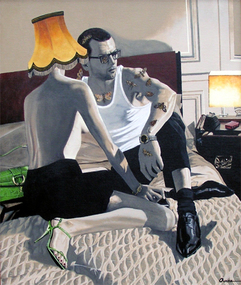 Written by Michael Ashman Surrealism has a captivating double edge that can either hypnotize the viewers or it can completely turn them off. Surreal art pieces express abstract concepts that cannot simply be understood like traditional art pieces. Instead, one must think of them as windows into the subconscious mind. Many times the dreams of the artist play a significant role in a surrealist piece. One such artist, Jimmy Ovadia, has talent for capturing mystical dreamscapes. His career as an artist took off after proposing an album cover for one of his favorite bands, Louis XIV, from MySpace. Brian Karscig, from the band, keeps in contact and continues to help him with his continuing works. He grew up in San Diego and has contributed his artwork to places around the community. For example, he collaborates with local bands and The Casbah to create poster and flyer designs for them. He continues to come up with new and better ideas, and becoming a father has made him work harder at what he loves. In a San Diego CityBeat article he says, “I decided I had to go big, or go home.” Ovadia’s art looks a lot like snapshots taken from his own dreams. For example, the bedroom setting in his work “Attraction” looks normal enough, but the figures in it are far from it. There are many things to uncover in this work. First, the woman in the painting is wearing a yellow lampshade over her head—different from the ordinary one on the nightstand. It’s the kind of frilly lampshade that mimics the dress of a seductive dancer. Second, there are moths climbing everywhere on the man relaxing on the bed. He is not fazed by them at all, even the ones that crawl over his face. They are only attracted to him just like the woman. According to CityBeat, Jimmy explains why he uses moths, “It shows passion, love and being drawn in and captivated by something.” Then it is no coincidence why he chose to put them in this painting called “Attraction.” Finally, the color green on the woman’s purse and shoe is a color that sticks out from the dimly lit room. Green can represent the safety that she feels with him—she is already half-naked and longing for him. Surrealism is about looking past the woman wearing a lampshade, and the man covered in moths, to find the hidden emotions that tie into the subconscious mind. Jimmy Ovadia imaginative and unrestricted abstract surrealism is something to wonder upon. His inspiration primarily comes from music and draws from its rhythm. He recently was the winner of Scholljah Art Promotion's inaugural Art Battle at the Belly Up Bar thanks to the inspiration from two musical groups, Beyond I Sight and The Simpkin Project. Prints of “Attraction” and other works by Jimmy Ovadia can be bought at Thumbprint Gallery, 920 Kline St. in La Jolla. The gallery is open Wednesdays, Thursdays, Fridays and Saturdays from 12pm to 4pm.
0 Comments
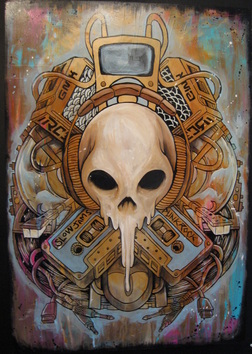 Written by Michael Ashman Indeed, while the nature of music and what it does for us has not changed over the centuries, the way we listen to it certainly has. Live music is always the best, but ever since we created the technology to record music, we have always tried to improve upon it. Today, the diversity of music storage is numerous. But when one way becomes more convenient, the old way quickly becomes obsolete. In his new work “Music for the Soul,” GMONIK captures the evolution of music technology throughout the years by painting a tower of music devices representing just about every popular medium of the past century. Starting with a turntable and vinyl records at the base, he builds up from there with 8-track cartridges, cassette tapes, and CDs. One can even feel a pang of nostalgia for the mix-tape generation, as GMONIK recreates handwritten labels on the cassette tapes—one for “Slow Jams” and one for “Punk Rock.” All the music devices in the work surround the central skull like a memorial. However, it is at the very top that the new digital format reigns: the iPod mp3 player. Its wires wrap around the 8-track cartridges and past the CDs and appear to connect into the headphones of the skull at the center of it all. Is the skull listening to music from the past, or is it remembering what used to be the “new way” to listen to music? It must be some good mind-melting music because the grey skull looks like it is dripping down the canvas, over the cassettes, over some music making accessories. The cool pinks and blues and acid purples give the painting a melancholy vibe, suggesting the deep and meaningful ways that music impacts our lives. Whoever this skull belonged to definitely loved music. And music is a big part in GMONIK’s other works, which are on display at Thumbprint Gallery at 920 Kline Street in La Jolla. The “City Dreams” exhibit by GMONIK features surreal mixed media art about music, technology, and wild beasts. The gallery is open Wednesdays, Thursdays, Fridays, and Saturdays from 12pm to 4pm. The show will be on exhibit until February 3. We will also be hosting a second reception for GMONIK on January 25 from 4 p.m. to 9 p.m. 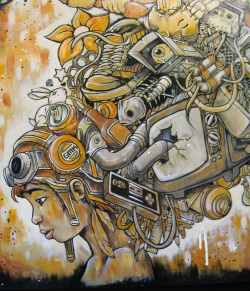 Written by Michael Ashman Whether it is the next Apple product, video game console, or latest techno-gadget that makes a task easier, technology is all around us. Its ever-changing and growing form adds more and more possessions to our daily life, and more waste as other gizmos become obsolete. Technology is almost impossible to ignore, and GMONIK shows us how it tolls upon our thoughts as we go about our lives in his work called “Used” currently on display at Thumbprint Gallery. The things we interact with daily, from ATMs to laptop computers, are all powered by technology. The girl wearing headphones in this artwork looks like she also has to deal with the same numerous electronic gadgets, as seen spewing out of the back of her head. Objects such as, a TV, a toaster, a cell phone, and boombox intertwine with other non-electronic items such as, sneakers, beer, flowers, and even a rubix cube. Her expressionless stare tells us that she is probably daydreaming about the things sprouting behind her. With so many things on her mind, she becomes distant from the city landscape behind her. Her world seems to revolve around the many material goods that make up her life. 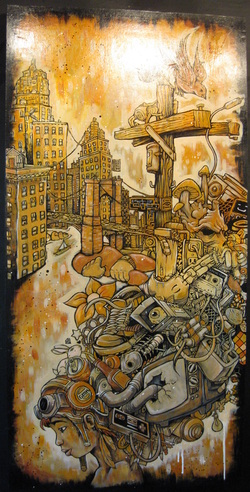 The city is full of unavoidable technology. Flashing billboards, noisy traffic, satellite dishes, and security cameras make up most of the cityscape. GMONIK incorporates things, such as the satellite dish and closed-circuit security camera, into the painting to show technology that watches us, instead of the other way around. Another female figure in the artwork appears to be sleeping peacefully in the river of the city, but is still being fed the noise of the bustling city as her open mouth catches the flow of cars from the bridge. She is a part of the city, laying her head down on the same things that are a part of the other girl’s mind. This work has a surreal and free-flowing design around the city and the technology in it. The painting flashes into existence with a warm sunset orange color. The collection of things growing from the back of her head and the sleeping giant in the river add surrealism to this dreamlike image. He uses a mixture of acrylic, ink and dripping spray paint to create an imaginative scene that leads the eye from the city to the girl’s head in the foreground. There are so many things to think about when viewing this work. “Used” by GMONIK is one of many works currently on display at Thumbprint Gallery’s “City Dreams” exhibit. To see this piece and more of GMONIK’s artwork visit Thumbprint Gallery on Kline Street in La Jolla. The gallery is open Wednesdays, Thursdays, Fridays, and Saturdays from 12pm to 4pm. The show will be on exhibit until February 3. Also, for those who missed the opening reception the gallery will be holding a second reception on January 25 from 4pm to 9pm. 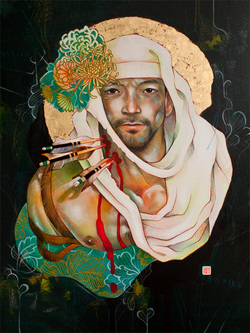 Written By Michael Ashman The history of remembering the fallen, the sacrifices of martyrs and their strength to defend their actions has been a subject of art for a long time. Intertwined with their contributions to history is how they died. Christian martyrs have always been a part of art history. The ways they died were immortalized in painting; one famous was the display of Saint Bartholomew’s skin after being flayed alive in Michelangelo’s Sistine Chapel altar wall painting “The Last Judgment.” What may not be familiar to most of us are martyrs in Japanese folklore. That is where Japanese American artist JUURI helps us to see both sides by combining two histories into one with her painting “The Standing Death of Ben-Kei St. Sebastian.” St. Sebastian and Ben-Kei share a similar trial by arrows for protecting their convictions. JUURI’s art piece demonstrates a balanced combination of characteristics shared by these two men, and shows it through her artistic expression and creativity. The stories behind these two unfortunate protagonists mix well with each other. On one side is St. Sebastian, a man persecuted for his Christian beliefs. He was sentenced to death by arrows. He is commonly depicted standing, tied to a pole or tree, with arrows piercing his skin. He was not killed by this initial torture and survived. Only after his rescue was he finally stoned to death. On the other side is Ben-Kei, a Japanese monk warrior that fought to protect his master. After bravely fighting off many attackers, he succumbs to multiple arrow shots. However, as stated in the folklore, when enemy soldiers came upon his body, he was still standing after taking his last breath before falling over. The conclusion to these stories is their unbelievable strong will to survive, and loyalty to protect their beliefs until the very last breath. “The Standing Death of Ben-Kei St. Sebastian” is a mix of art styles. In this painting, JUURI uses mostly colored pencil, acrylic, and watercolor with some gold leaf. The portrait of Ben-Kei St. Sebastian illustrates the combined death of both characters in one person. His expressionless face and defined body are idealized, despite the fact that arrows have pierced his neck creating agonizing bloody wounds. Adding further to the purity of this piece, his white head cowl is clean of any blood stains. A gold leaf halo surrounds his head. It can either represent an actual halo, in terms of St. Sebastian’s Christian faith, or a glowing moon as a backdrop for Ben-Kei’s stoic pose. Switching from the more traditional style of his body, the background around him is more abstract. Swirling floral patterns and floating text against a deep black surface creates a setting devoid of location. JUURI also wrote a short poem about “The Standing Death of Ben-Kei St. Sebastian” to complement the painting. In her poem, she creatively shortens the experience of death felt by these two men. The emotion of what could have been their final thoughts is very poignant. One can get a sense of the men’s loyalty to their king and devotion to protect him, even if may have been in vain. Looking at the painting and reading the poem definitely enhances the overall the viewing experience. Prints of “The Standing Death of Ben-Kei St. Sebastian” by JUURI are exclusively available at Thumbprint Gallery and on our online store. To see the print and the poem together, click here. The public is welcome to visit Thumbprint Gallery at 920 Kline Street in La Jolla. The gallery is open Wednesdays, Thursdays, Fridays, and Saturdays from 12pm to 4pm. |
Archives
June 2022
|

